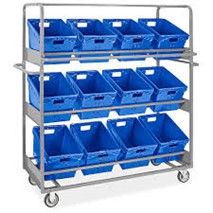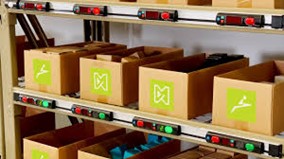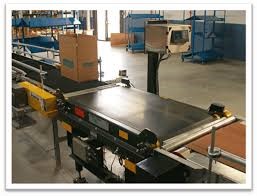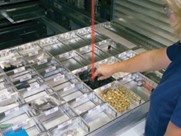Does your order fulfillment process need a boost? With these picking techniques, get ready to maximize productivity, accuracy, and efficiency.
Improving Pick Speed:
Pick and replenish at different times:
By implementing a strategy of separating the put-away and picking functions, you can significantly improve the efficiency of your warehouse operations. This approach not only reduces congestion in the aisle, which can slow down both functions but also ensures that pickers aren’t picking locations before they are replenished. This separation is particularly crucial when incorporating various types of automated equipment, such as Automated Storage and Retrieval systems (ASRS) or Vertical Lift Modules (VLMs). While these automated systems are highly efficient and fast, they often have limited operator stations, making the separation of functions even more beneficial.
Pick multiple orders:
Instead of picking one order at a time, picking multiple orders greatly increases the number of orders a picker can process

A pick cart allows you to pick multiple orders as you wind your way through the warehouse to complete your orders. While a pick cart can be used without a Warehouse Management System (WMS), the amount of paperwork and scanning all 12 orders (in this instance) to ensure you’ve picked all your orders completely can be overwhelming. On the other hand, a WMS simplifies this process by eliminating the need for the picker to manually keep track of all 12 orders to ensure they’ve picked all their orders completely.
Another technology that will significantly improve picking speed is once again picking multiple orders at a time, except this time with a batch table and put lights.
The batch table with put lights is typically associated with goods-to-picker equipment such as an ASRS or a VLM. In this

Pick and pass:
When orders are picked in large distribution centers, it is typically inefficient for the picker to walk throughout the picking area to complete each order. A pick-and-pass system is put in place where pickers are responsible for certain pick zones within the warehouse. They’ll pick the portion of the order in their zone and pass the order to the next zone, and so on until the order is picked and completed. This allows the picker to focus on their zone and not have to walk long distances to complete an order.
Efficient pick path:
In a paper-picking environment (without a WMS), it isn’t easy to efficiently manage a pick path if you pick multiple orders at a time. You need to juggle where all the various items are on your pick list and make sure you’re scanning all the orders for picks before moving on to the next aisle or zone. A WMS is a tremendous benefit for creating an efficient pick path. The WMS knows where all your product is located and the SKUs you need to pick for your multiple orders. With Radio Frequency enabled in your facility, your WMS can even determine where you are and start your pick path from your current location.
Productivity incentives:
A common practice in high throughput operations, such as grocery distribution, is a picking-based incentive program that rewards the pickers for meeting and exceeding certain picking rates. Although these incentive systems are very effective in increasing pick speed, they are typically tied to an accuracy threshold as well.
Group common items in the same area:
When it comes to slotting (storage location of items), it’s always best to keep items commonly purchased together close to each other. For example, if I ran an office supply warehouse and customers who ordered pencils frequently ordered erasers at the same time, I would store those items close to each other to minimize the travel distance between the two picks and increase picking speed.
Improving Accuracy:
Warehouse Management Software (WMS):
Picking accuracy starts with accurate put-aways (replenishments). If items are put away in the wrong location, then the speed and accuracy of picks are doomed.
A WMS will significantly increase your order accuracy. For one, the WMS drives the replenishment of your pick locations and can force the replenisher to scan the item & location to verify that they have the right SKU in the proper location.
For picking, the WMS will first sequence the picks to route the picker in the most efficient pick path to complete the order, or the part of an order they are picking. The WMS can also force the picker to scan and verify the SKU location, the SKU itself, or both to ensure they are at the right location and have picked the right product.
Order checkers:
Companies struggling with order accuracy often incorporate order checkers into their operations. While this strategy will increase order accuracy, it is very inefficient, slowing down order processing and adding labor costs to the operation.
Weigh scales (weigh bag and tag):
When a customer order calls for large quantities of small items (2,000 flat head washers, for instance), the only efficient way to count them accurately is with a weigh scale. The weigh scales work by getting a reference to how much each washer weighs. This is done by putting ten washers on the scale and having the scale weigh that quantity; the scale does the quick math and now knows how much each washer weighs. From there, you start loading the washers onto the scale, and the scale will tell you when the weight equals 2,000 washers.
In-Motion weigh scales:
Another means of accuracy checking is with weigh-in-motion scales.

Weigh-in-motion scales will only work if your WMS knows the weight of each SKU in your warehouse. If you have that information (typically gathered from your suppliers), then if an order contains 12 SKUs and they are all packed in a single carton, you will know how much that carton should weigh. The carton is conveyed across a scale that weighs the carton and compares it to what the WMS says the carton should weigh; if everything checks, then the carton continues on its way to shipping. If the carton does not weigh what it should, it is diverted off the conveyor system for manual checking.
Pick to light technology:
Pick to light systems will increase the speed and accuracy of picks in many applications. They can be incorporated into

The concept is simple: there is a light pointer of some sort that illuminates the correct pick location. The different types of pick to light systems and the various ways a pick to light system can be incorporated are too numerous for this discussion, but as a general statement, pick to light systems are a tremendous way to increase both the speed and accuracy of picking.
When replenishing, pick to light systems become put to light systems, driving the replenisher to the correct location for put-away.
Speed and accuracy in picking orders are paramount to an efficient and effective operation. There are many ways to improve picking speed and accuracy; you must determine which method, or methods, work best for your operation.
Let us know if you’d like to discuss what options may work best for you. We perform this type of analysis all the time.



Leave a Reply
You must be logged in to post a comment.